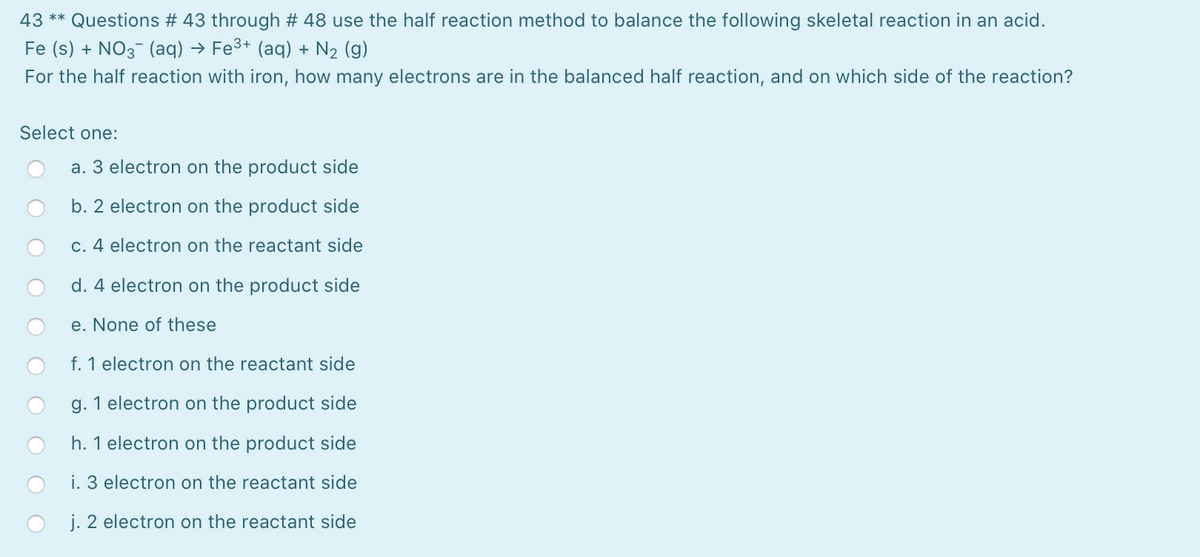43 ** Questions # 43 through # 48 use the half reaction method to balance the following skeletal reaction in an acid. Fe (s) + NO3- (aq) → Fe3+ (aq) + N2 (g) For the half reaction with iron, how many electrons are in the balanced half reaction, and on which side of the reaction? Select one: a. 3 electron on the product side b. 2 electron on the product side c. 4 electron on the reactant side d. 4 electron on the product side e. None of these f. 1 electron on the reactant side g. 1 electron on the product side h. 1 electron on the product side i. 3 electron on the reactant side j. 2 electron on the reactant side
43 ** Questions # 43 through # 48 use the half reaction method to balance the following skeletal reaction in an acid. Fe (s) + NO3- (aq) → Fe3+ (aq) + N2 (g) For the half reaction with iron, how many electrons are in the balanced half reaction, and on which side of the reaction? Select one: a. 3 electron on the product side b. 2 electron on the product side c. 4 electron on the reactant side d. 4 electron on the product side e. None of these f. 1 electron on the reactant side g. 1 electron on the product side h. 1 electron on the product side i. 3 electron on the reactant side j. 2 electron on the reactant side
Chemistry & Chemical Reactivity
10th Edition
ISBN:9781337399074
Author:John C. Kotz, Paul M. Treichel, John Townsend, David Treichel
Publisher:John C. Kotz, Paul M. Treichel, John Townsend, David Treichel
Chapter19: Principles Of Chemical Reactivity: Electron Transfer Reactions
Section: Chapter Questions
Problem 45PS: An aqueous solution of KBr is placed in a beaker with two inert platinum electrodes. When the cell...
Related questions
Question

Transcribed Image Text:43 ** Questions # 43 through # 48 use the half reaction method to balance the following skeletal reaction in an acid.
Fe (s) + NO3- (aq) → Fe³+ (aq) + N2 (g)
For the half reaction with iron, how many electrons are in the balanced half reaction, and on which side of the reaction?
Select one:
a. 3 electron on the product side
b. 2 electron on the product side
c. 4 electron on the reactant side
d. 4 electron on the product side
e. None of these
f. 1 electron on the reactant side
g. 1 electron on the product side
h. 1 electron on the product side
i. 3 electron on the reactant side
j. 2 electron on the reactant side
Expert Solution
This question has been solved!
Explore an expertly crafted, step-by-step solution for a thorough understanding of key concepts.
This is a popular solution!
Trending now
This is a popular solution!
Step by step
Solved in 2 steps

Knowledge Booster
Learn more about
Need a deep-dive on the concept behind this application? Look no further. Learn more about this topic, chemistry and related others by exploring similar questions and additional content below.Recommended textbooks for you

Chemistry & Chemical Reactivity
Chemistry
ISBN:
9781337399074
Author:
John C. Kotz, Paul M. Treichel, John Townsend, David Treichel
Publisher:
Cengage Learning

Chemistry & Chemical Reactivity
Chemistry
ISBN:
9781133949640
Author:
John C. Kotz, Paul M. Treichel, John Townsend, David Treichel
Publisher:
Cengage Learning

World of Chemistry, 3rd edition
Chemistry
ISBN:
9781133109655
Author:
Steven S. Zumdahl, Susan L. Zumdahl, Donald J. DeCoste
Publisher:
Brooks / Cole / Cengage Learning

Chemistry & Chemical Reactivity
Chemistry
ISBN:
9781337399074
Author:
John C. Kotz, Paul M. Treichel, John Townsend, David Treichel
Publisher:
Cengage Learning

Chemistry & Chemical Reactivity
Chemistry
ISBN:
9781133949640
Author:
John C. Kotz, Paul M. Treichel, John Townsend, David Treichel
Publisher:
Cengage Learning

World of Chemistry, 3rd edition
Chemistry
ISBN:
9781133109655
Author:
Steven S. Zumdahl, Susan L. Zumdahl, Donald J. DeCoste
Publisher:
Brooks / Cole / Cengage Learning

Chemistry for Today: General, Organic, and Bioche…
Chemistry
ISBN:
9781305960060
Author:
Spencer L. Seager, Michael R. Slabaugh, Maren S. Hansen
Publisher:
Cengage Learning

Chemistry by OpenStax (2015-05-04)
Chemistry
ISBN:
9781938168390
Author:
Klaus Theopold, Richard H Langley, Paul Flowers, William R. Robinson, Mark Blaser
Publisher:
OpenStax

Chemistry
Chemistry
ISBN:
9781305957404
Author:
Steven S. Zumdahl, Susan A. Zumdahl, Donald J. DeCoste
Publisher:
Cengage Learning